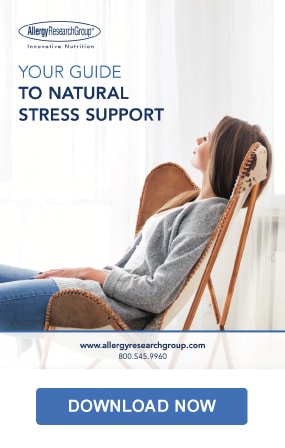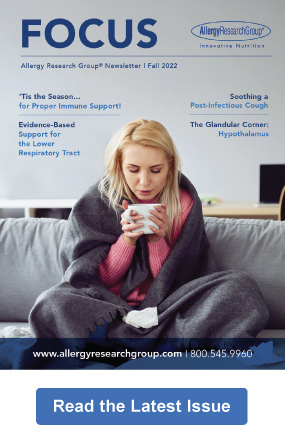Share this post
Relief from itchy eyes and wheezy lungs
Picture a latex balloon filled not only with helium gas, but also confetti. What would happen if somebody took a pin to the balloon? An exhilarating POP! would accompany the explosion of confetti, creating not only a racket, but also a mess.
Histamine “confetti”
A certain type of immune cell is a lot like the confetti-filled balloon. The mast cell, as it is known, is found throughout the body and is filled with confetti-like granules rich in heparin and histamine as well as many other molecules that call other immune cell responders to the scene. These granules are released into the body when the mast cells “pop” in a process known as degranulation, which can occur in the event of injury, infection, or allergy. If you’ve ever had an allergic reaction, you know all too well the effects of the histamine release that follows mast cell degranulation – symptoms like inflammation, itching, sneezing, nasal congestion, and watery eyes.[1]
Vitamin C has been shown to reduce the histamine response seen in allergies and asthma.
Those with allergic conditions like asthma, eczema, and allergic rhinitis tend to have “leakier” or less stable mast cells than those without allergies, in large part due to greater activity of immunoglobulin E (IgE), the major antibody in allergic disease.[2] Mast cell stabilization and histamine degradation are thus prominent goals in the treatment of allergic conditions.
Also known as ascorbic acid, vitamin C has been shown to reduce the histamine response seen in allergies and asthma.[3],[4],[5] In addition to supporting the joints,[6] building bone density,[7] alleviating anxiety,[8] reducing addiction-related cravings,[9] and enhancing resistance to infections,[10],[11] vitamin C is also a key player in taming allergic responses as one of the most readily available mast cell stabilizers.[12],[13]
Eosinophils, the allergic cells
In addition to mast cells, a type of white blood cell known as the eosinophil helps control the response seen in allergies and asthma. In healthy individuals, eosinophils comprise only 1-3% of all white blood cells in the body, but the count is higher in those with allergic conditions or asthma.[14] Eosinophils can also congregate in a specific body part and cause inflammation and tissue damage, as is seen in various advanced allergic conditions like asthma (when the eosinophils infiltrate the lungs) and allergic rhinitis (when they accumulate in the mucus membranes of the sinuses and nose).[15] The development of eosinophils occurs in the bone marrow, specifically when the marrow is stimulated by an immune cytokine known as interleukin 5 (IL-5).[16]
Thankfully, vitamin C might may help dampen these eosinophil-related pro-allergic events. In fact, vitamin C has been shown to lower IL-5 expression and reduce eosinophilic infiltration of the lungs in a study performed on rats with asthma.[17]
Antioxidant activity of vitamin C
Epidemiological studies show that vitamin C consumption is inversely related to asthma incidence, suggesting that diets low in vitamin C increase one’s risk of developing asthma. It has also been shown that those who already have asthma experience fewer symptoms of the condition when they take vitamin C supplements.[18]
Those who have asthma experience fewer symptoms of the condition when they take vitamin C supplements.
In addition to the above-described actions of vitamin C, the nutrient can further offer protection to the lungs by acting as an antioxidant. The free radical scavenging activity of vitamin C acts throughout the body, including the mucus membranes of the lungs. In this way vitamin C can protect the lungs against both the oxidative stress caused by products made within the body and by inhaled triggers from the environment.[19]
Vitamin C, adrenals, and allergies
Vitamin C is stored in many tissues throughout the body, with the highest concentrations residing in the adrenal glands.[20] Located above the kidneys, the adrenal glands produce cortisol, a hormone that not only helps us react to and deal with stress but also moderates our immune system response.[21] The same stress-driven signals that cause the adrenal glands to secrete cortisol also cause them to release ascorbic acid (vitamin C) into the blood.[22] In other words, the more stress we experience, the more our adrenal glands pump out ascorbic acid, and the more likely we are to become deficient in vitamin C. To make matters worse, cortisol itself slows the adrenal glands’ ability to accumulate the ascorbic acid they need to keep up. Putting it simply, stress cuts off the adrenal glands’ ability to absorb vitamin C while simultaneously draining the vitamin C reserves they contain.[23] This is one of the mechanisms by which stress can predispose us to allergic troubles, and why those of us dealing with high stress levels could benefit from some extra vitamin C in our diets and/or supplement regimens.
The more stress we experience, the more our adrenal glands pump out ascorbic acid, and the more likely we are to become deficient in vitamin C.
Because vitamin C is water-soluble, excess amounts are flushed out in the urine. Unlike vitamin D3, which can be stored in the fat tissue,[24] vitamin C passes through the body and then is literally flushed down the toilet. Humans, furthermore, are one of the few species on earth that cannot synthesize vitamin C and must obtain it from nutritional sources.[25] Regular intake of vitamin C is therefore important to ensure optimal health, in allergy season and beyond.
Click here to see References
[1] Zhang T, et al. Mast cell stabilisers. Eur J Pharmacol. 2016 May 5;778:158-68.
[2] Owen CE. Immunoglobulin E: role in asthma and allergic disease: lessons from the clinic. Pharmacol. Ther. 2007;113:121-33.
[3] Levine MA, Pollard HB. Hydrocortisone inhibition of ascorbic acid transport by chromaffin cells. FEBS Lett. 1983;158(1):134-8.
[4] Hatch GE. Asthma, inhaled oxidants, and dietary antioxidants. Am J Clin Nutr. 1995 Mar;61(3 Suppl):625S-30S.
[5] Bielory L, et al. Asthma and vitamin C. Ann Allergy. 1994 Aug;73(2):89-96.
[6] Chiu PR, et al. Vitamin C protects chondrocytes against monosodium iodoacetate-induced osteoarthritis by multiple pathways. Int J Mol Sci. 2016 Dec 27;18(1):38.
[7] Kim YA, et al. Favorable effect of dietary vitamin C on bone mineral density in postmenopausal women (KNHANES IV, 2009): discrepancies regarding skeletal sites, age, and vitamin D status. Osteoporos Int. 2015 Sep;26(9):2329-37.
[8] de Oliveira IJ, et al. Effects of oral vitamin C supplementation on anxiety in students: a double-blind, randomized, placebo-controlled trial. Pak J Biol Sci. 2015 Jan;18(1):11-8.
[9] Newmeyer J, et al. Efficacy of buffered ascorbate compound (BAC) in the detoxification and aftercare of clients involved in opiate and stimulant abuse. From the Haight-Ashbury Free Medical Clinic. 1983 Jul:1-5.
[10] Douglas RM, et al. Vitamin C for preventing and treating the common cold. Cochrane Database Syst Rev. 2007 Jul 18;(3):CD000980.
[11] Hemilä H. Vitamin C and infections. Nutrients. 2017 Mar 29;9(4):339.
[12] Johnston CS. The antihistamine action of ascorbic acid. Subcell Biochem. 1996;25:189-213.
[13] Anogeianaki A, et al. Vitamins and mast cells. Int J Immunopathol Pharmacol. 2010 Oct-Dec;23(4):991-6.
[14] Uhm TG, et al. Eosinophil development, regulation of eosinophil-specific genes, and role of eosinophils in the pathogenesis of asthma. Allergy Asthma Immunol Res. 2012 Mar;4(2):68-79.
[15] Lambrecht BN, Hammad H. The immunology of asthma. Nature Immunology. Jan 2015;16(1):45-56.
[16] Rosenberg HF, et al. Eosinophil trafficking in allergy and asthma. J Allergy Clin Immunol. 2007 Jun;119(6):1303-10.
[17] Chang HH, et al. High dose vitamin C supplementation increases the Th1/Th2 cytokine secretion ratio, but decreases eosinophilic infiltration in bronchoalveolar lavage fluid of ovalbumin-sensitized and challenged mice. J Agric Food Chem. 2009 Nov 11;57(21):10471-6.
[18] Nagdeote AN, et al. Protective role of ascorbic acid in bronchial asthma. J Pharm Sci Res. 2015 Aug 1;7(8):560.
[19] Hatch GE. Asthma, inhaled oxidants, and dietary antioxidants. Am J Clin Nutr. 1995 Mar;61(3 Suppl):625S-30S.
[20] Patak P, et al. Vitamin C is an important cofactor for both adrenal cortex and adrenal medulla. Endocr Res. 2004 Nov;30(4):871-5.
[21] Wamboldt MZ, et al. Adolescents with atopic disorders have an attenuated cortisol response to laboratory stress. J Allergy Clin Immunol. 2003 Mar;111(3):509-14.
[22] Padayatty SJ, et al. Human adrenal glands secrete vitamin C in response to adrenocorticotrophic hormone. Am J Clin Nutr. 2007 Jul; 86(1):145-9.
[23] Levine MA, Pollard HB. Hydrocortisone inhibition of ascorbic acid transport by chromaffin cells. FEBS Lett. 1983;158(1):134-8.
[24] Nair R, Maseeh A. Vitamin D: the “sunshine” vitamin. J Pharmacol Pharmacother. 2012 Apr;3(2):118-26.
[25] Padayatty SJ, Levine M. Vitamin C: the known and the unknown and Goldilocks. Oral Dis. 2016 Sep;22(6):463-93.
The information provided is for educational purposes only. Consult your physician or healthcare provider if you have specific questions before instituting any changes in your daily lifestyle including changes in diet, exercise, and supplement use.
Share this post
Dr. Erica Zelfand
Related posts
A Resinous Extract For Liver Health and Repair
Nonalcoholic fatty liver disease (NAFLD) has quickly become the leading cause of liver disease in the Western world.[1] The current recommendations upon first diagnosis of NAFLD are diet and lifestyle management. While these are certainly the most important places to start, as a clinician, I find these recommendations to be difficult for some of…
Protecting Yourself from the Damaging Effects of Air Pollution
How to keep your cells healthy in the face of particulate matter pollution in the air The more populated our world becomes, the more the by-products of development, consumerism, and transportation become an issue. Many of the effects are obvious: we can’t avoid seeing supermarkets popping up where there once were trees, new shiny…
Nrf2, Antioxidant Superhero
Fighting oxidative stress and inflammation with natural substances If you cut up an apple and leave it on the counter, you may notice its white flesh turn to brown. A similar effect happens to our own cells when they’re exposed to unstable molecules known as free radicals. This “rusting,” or “browning” process is called…
Support for ADHD, Focus, and Mood in Children
Support for ADHD, focus, and mood Whether it’s full-blown attention deficit hyperactivity disorder (ADHD), autism spectrum disorder (ASD), or a milder form of neurocognitive irritation, more and more of us are struggling with anxiety, inattention, hyperactivity, behavior issues, learning disabilities, and sleep disturbances. Through targeted nutritional support, however, there is hope for both adults…
Fatty Liver Disease: Thyroid Function and Gut Health as Disease Risk Factors
Factors beyond diabetes and obesity which may contribute to the development of non-alcoholic fatty liver disease Perhaps you had a recent screening physical for work, or you hit that magic age of 50 when your doctor suddenly wanted to test “everything” to assess your overall health and disease risk factors. Either way, one of…
Big Pharma Banks on Fatty Liver Disease
Where there’s a buck to be made… With rapidly increasing rates of obesity and metabolic syndrome, nonalcoholic fatty liver disease (NAFLD) has become the most common causes of chronic liver disease in Western countries.[1] NAFLD affects 10 to 46% of the United States population, with a worldwide prevalence of 6 to 35%.[2] Actual numbers,…
Categories
- Botanicals (56)
- GI Health (53)
- Healthy Aging (121)
- Immune Support (39)
- In The News (39)
- Kids Health (21)
- Stress and Relaxation (50)
- Uncategorized (1)
- Video (9)
- Vitamins & Minerals (51)




